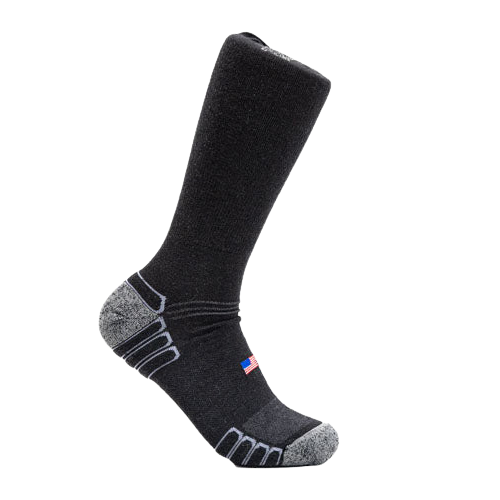There’s nothing more annoying than a squeaky boot—it’s all you can focus on while at work. It’s like having something stuck in your teeth—you can’t stop poking at it, even though it’s not the end of the world.
By the end of this easy tutorial, I’ll have shown you what parts of your work boots are most likely to squeak and, more importantly, how to stop it from happening. It depends on where the squeak comes from, but each fix is simple and quick.
By the end of this article you’ll know how to glide silently across even the shiniest tile floors.
What You’ll Need to Stop Your Boots from Squeaking
There are only a few key places your boots will squeak from, so our first step is identifying where the annoying noise is coming from. Once you’ve found where the issue is, you’ll need one of the below items to stop your boots from squeaking:
- Talcum powder
- Low-grit sandpaper (80-120 grit is ideal)
- Dryer sheets
Before you even make a start, ensure your boots are clean, free of mud and grime, and that you’ve made sure they’re dry. Wet talcum powder turns into a paste, and it’s like getting cement off when it dries, so wipe those boots dry.
How to Stop Leather Boots from Squeaking
Silencing a Squeaky Tongue
If the tongue of your work boot squeaks, there’s a quick fix that will stop the tongue from rubbing against the upper part of the boots. New boots, especially leather work boots, tend to be stiff, meaning there’s less give in the material.
All you’ll need to stop the tongue squeaking is some good old-fashioned talcum powder—I use Johnson’s Baby Powder because I’ve got kids, and kids mean talcum powder. Johnson’s is a classic for good reason—the company has been going strong since 1886, and their products are trusted worldwide.
Johnson’s Baby Powder is designed for two things—absorbing moisture, and reducing friction, and that’s exactly what we’re after for out squeaky boots.
Step 1: Make Space Around the Tongue
Before applying the talcum powder, you’ll need to ensure you can get into any crevices that could be causing the squeak. Even the smallest area of the leather could be causing the tongue to rub, so you need to get right in there.
Remove your laces and push down the tongue so that it’s touching the sole of your boot. The closer it is to the heel of your boot, the further in you’ll be able to apply talcum powder.
Step 2: Rub in the Talcum Powder
Put some talcum powder into the palm of your hand and rub it into the tongue of your boot, covering it from the base, where it’s attached, to the top. You can be pretty liberal—it’s not hard to clean off talcum powder as long as your boots are dry.
Make sure you get the powder in as far down the tongue as possible and even rub some into the upper of your boots on the inside. Behind the eyelets is often where the tongue rubs, so doubling up and applying talcum powder there is a good tip to follow.
Step 3: Remove the Excess Talcum Powder
You don’t want to be walking around looking like Frosty the Snowman, so you’ll need to remove any talcum powder that’s not rubbed into the leather. The powder stops two pieces of leather from rubbing together, but it doesn’t have to be caked in it.
Turn your boots upside down and give them a good whack to get any excess talcum powder out. If you’ve been a bit over the top, you can vacuum out the powder—as long as you’ve rubbed enough into the tongue, the squeak will have vanished.
Wipe off your boots with a dry cloth, and boom, a silent tongue sits in your boot, never to squeak again.
Reduce Friction for a Silent Stroll
If the sole of your boot makes annoying noises when you’re on hard floors, you’ve got two choices—adding friction or removing it. This fix for squeaky boots is all about reducing the friction between the sole of your boot and the ground.
I can’t stress enough that you try this before trying to add friction, which is my next tip. Once you’ve sanded the sole of your boots, there’s no going back, so try to reduce friction first. All you’ll need to reduce the friction is a handy dryer sheet.
If you’ve got a dryer, you’ll probably have some to hand. If not, I recommend Bounce Fabric Softener Sheets because I use them and know they work. Dryer sheets are designed to make our clothes feel softer and fresher when they come out of the dryer, and we’re going to use that to our advantage.
Step 1: Clean Your Boots Thoroughly
You’ll be rubbing the dryer sheet over the soles of your boots, using the softening agents inside the sheet to reduce friction. Before you can do that, you’ll need to ensure nothing is on your boots’ sole.
It’s less about cleanliness and more about reducing the chance of anything on your sole reacting with the dryer sheet. Once you’ve cleaned your boots, wipe them down to ensure they’re dry.
Step 2: Add a Little Bounce to Your Walk
Scrub the sole of your boots with the dryer sheet, making sure you cover every part with the softening agent that’s in each sheet. The softening effect that dryer sheets have on clothes will work for us and leave a slight residue on the sole of your boots.
Once you’ve finished, don’t clean the boots again—you don’t want to wipe off the friction-reducing patina by taking a wet cloth to your boots.
Step 3: Try Out Your Boots
The good thing about using dryer sheets is that they fit easily into your bag. Your boots should now have less friction with the floor, and the squeak will have gone. The sheen doesn’t last forever, so having a sheet to hand in case you need a top-up is a good idea.
If you find the squeak persists, it’s probably because you needed to find more friction, not less. Let’s check out how to add a little more friction between your boots and the floor.
Sand Those Soles
Before any joiners out there get too excited, you’re not taking a power sander to your squeaky boots. We’re adding some additional grip to your boots, not sandblasting them. The idea behind sanding the sole of your boot is to roughen the sole slightly, creating more friction with the floor.
If you’re sure it’s the bottom of your boots that are squeaking, then you’ve got two options—increase friction, or decrease it. This step is to add a little friction by adding more grip to the sole of your work boots.
Whether you’re wearing new work boots or old, you don’t need to sand much off—in fact, using elbow grease and sandpaper would take months to make an impression on rubber soles. The effect will be more pronounced on leather, but as I said, we’re roughing up, not beating up.
Step 1: Clean Your Boots
Before sanding, you’ll need to ensure the bottom of your boots are clean. Any stones or debris stuck in the lugs need prising out with a screwdriver, and then you need to wipe your boots down.
Step 2: Roughen Up Your Boots
I’ve found that the rougher the sandpaper, the better this step goes. Sandpaper is graded, and the lower the grading, the rougher the sandpaper.
I use either 80-grit or 120-grit sandpaper like the Boshcraft 10 Pack Sanding Sponge, there are several grades of grit, and the sanding sponge makes gripping the sandpaper much easier.
Sand the soles of your boots, making sure to get right to the edges to maximize the extra grip. You’ll perhaps need to do this step a few times to get the right level of extra grip—try wearing your boots after sanding to see if they still squeak, and repeat until you’re happy.
Step 3: Finishing Off
Once my boots have stopped squeaking, I usually go over the sole of my boots again with a much finer sandpaper just to tidy things up.
The Boshcraft 10 Pack Sanding Sponge comes with a handy 220-grit sandpaper, and that’s fine for clearing any overly rough edges. Sure, you’re after a better grip, but you don’t want to scuff floors with your boots. You’re now squeaky clean, and your boots even feel more secure on the slippery floor.
Walking in Silence
There’s no more annoying noise than a squeaky boot, and simply leaving it to vanish over time isn’t really the best way to fix the problem. Walking around like you’re hiding a startled budgerigar in each sock can be a bit frustrating, so wanting to share these easy fixes was a no-brainer.
There aren’t many spots on your boot that’ll cause a squeak, and there’s an incredibly easy fix for each potential area that’s quick to implement and needs very few materials to get the job done.
I hope you’ve found these fixes helpful and that you’ve been able to identify and fix the squawk in your own boots.






